SUBARU advanced frontal airbag system
Your vehicle is equipped with a SUBARU advanced frontal airbag system that complies with the new advanced frontal airbag requirements in the amended Federal Motor Vehicle Safety Standard (FMVSS) No. 208.
The SUBARU advanced frontal airbag system automatically determines the deployment force of the driverís SRS frontal airbag at the time of deployment as well as whether or not to activate the front passengerís SRS frontal airbag and, if activated, the deployment force of the SRS frontal airbag at the time of deployment.
Your vehicle has warning labels on the driverís and front passengerís sun visors beginning with the phrase ďEVEN WITH ADVANCED AIR BAGSĒ and a tag attached to the glove box lid beginning with the phrase ďEven with Advanced Air BagsĒ. Make sure that you carefully read the instructions on the warning labels and tag.
Always wear your seatbelt. The SUBARU advanced frontal airbag system is a supplemental restraint system and must be used in combination with a seatbelt. All occupants should wear a seatbelt or be seated in an appropriate child restraint system.
The driverís SRS frontal airbag is stowed in the center portion of the steering wheel.
The front passengerís SRS frontal airbag is stowed near the top of the dashboard under an ďSRS AIRBAGĒ mark.
In a moderate to severe frontal collision, the driverís and front passengerís SRS frontal airbags deploy and supplement the seatbelts by reducing the impact on the driverís and front passengerís head and chest.
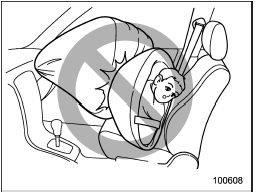

NEVER INSTALL A REARWARD FACING CHILD SEAT IN THE FRONT SEAT. DOING SO RISKS SERIOUS INJURY OR DEATH TO THE CHILD BY PLACING THE CHILDíS HEAD TOO CLOSE TO THE SRS AIRBAG.
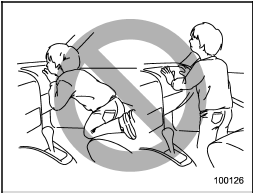

Never allow a child to stand up, or to kneel on the front passengerís seat.
The SRS airbag deploys with considerable force and can injure or even kill the child.
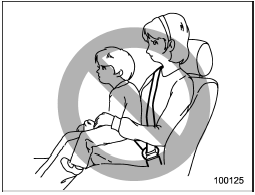

Never hold a child on your lap or in your arms. The SRS airbag deploys with considerable force and can injure or even kill the child.
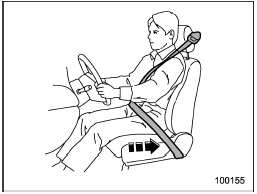

The SRS airbag deploys with considerable speed and force. Occupants who are out of proper position when the SRS airbag deploys could suffer very serious injuries. Because the SRS airbag needs enough space for deployment, the driver should always sit upright and well back in the seat as far from the steering wheel as practical while still maintaining full vehicle control and the front passenger should move the seat as far back as possible and sit upright and well back in the seat.
It is also important to wear your seatbelt to help avoid injuries that can result when the SRS airbag contacts an occupant not in proper position such as one thrown toward the front of the vehicle during preaccident braking.
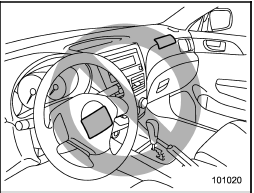

Do not put any objects over the steering wheel pad and dashboard.
If the SRS frontal airbag deploys, those objects could interfere with its proper operation and could be propelled inside the vehicle and cause injury.
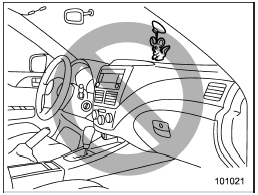

Do not attach accessories to the windshield, or fit an extra-wide mirror over the rear view mirror. If the SRS airbag deploys, those objects could become projectiles that could seriously injure vehicle occupants.
See also:
Adverse safety consequences of overloading on handling and stopping and on tires
Overloading could affect vehicle handling, stopping distance, vehicle and tire
as shown in the following. This could lead to an accident and possibly result in
severe personal injury.
● Veh ...
SRS CS Auto setting (type B audio)
SRS CS Auto can be set ON/OFF. When this setting is ON, ďĒ is displayed
on the screen.
NOTE
SRS CS Auto creates a 5.1ch equivalent surround field using 10 speakers that are installed in the vehicl ...
Bluetoothģ audio (type C and D audio)
This function enables you to play back
audio sources from Bluetoothģ audio
devices. You need to register the Bluetooth
ģ audio device in the system before
using it. ...


